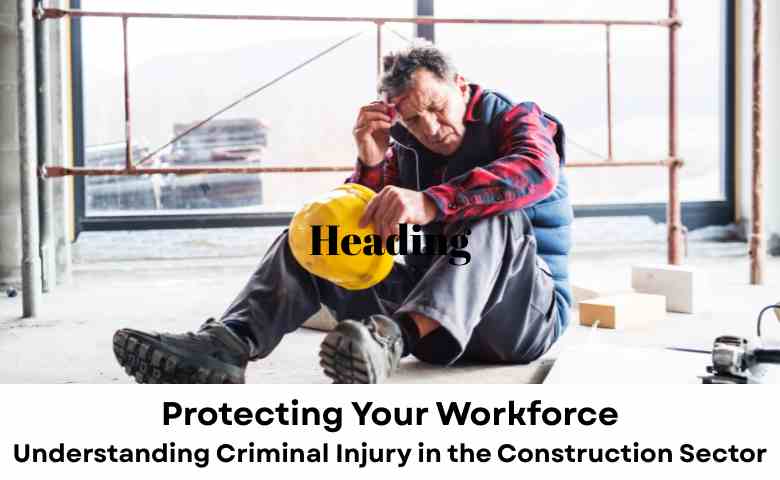Last Updated on April 3, 2025 by Admin
The construction industry is vital to any economy, providing essential infrastructure and employment opportunities. However, it also poses significant risks, with workers frequently exposed to hazardous conditions. Understanding criminal injury within this context is crucial for safeguarding your workforce and ensuring a safe working environment.
Criminal injuries in the construction sector can arise from incidents such as workplace violence, assaults, or other criminal acts. These incidents not only cause physical and emotional harm to victims but can also lead to substantial financial and legal consequences for employers. Partnering with experienced criminal injury lawyers can help you navigate these challenges, ensuring fair treatment and compensation for affected employees.
In this article, we’ll explore some of the risks associated with the construction sector and some safety measures that you might want to implement, breaking down the role of employers and how and where they may want to consider the legal implications that they may face if accused of causing or allowing for criminal injuries to their employees. We’ll guide you through creating a culture of safety in order to prevent problems wherever possible, leaving you empowered to make the right choices for you and your business.
Table of Contents
Understanding the Risks
The construction sector is inherently dangerous, with numerous daily risks that could lead to criminal injuries. Understanding these risks is the first step in implementing effective safety measures.
Some common causes of criminal injury include:
- Workplace Violence: Tensions can run high on construction sites, sometimes leading to altercations.
- Theft and Vandalism: Construction sites can be targets for theft, potentially leading to violent incidents.
- Intruders: Unauthorised individuals may enter the site, resulting in criminal acts.
With these risks in mind, it becomes crucial to establish comprehensive security measures to protect your workers

Implementing Safety Measures
To mitigate the risk of criminal injury, a well-thought-out safety plan is essential. Here are some strategies to consider:
- Conduct Thorough Risk Assessments: Regularly evaluate the site for potential hazards and adjust your safety protocols accordingly.
- Enhance Site Security: Implement robust security measures, including surveillance cameras and restricted access areas.
- Provide Employee Training: Educate workers on how to recognise and report suspicious activities.
For further guidance on creating a safe work environment, refer to the Health and Safety Executive (HSE) resource on workplace safety.
The Role of Employers
Employers play a pivotal role in preventing criminal injuries. Ensuring compliance with safety standards and providing adequate resources is fundamental in protecting your workforce. For detailed information on employer responsibilities, visit this guide to the employer duty of care.
By taking a proactive approach, you can significantly minimise the risks associated with criminal injuries, creating a safer and more secure work environment for all employees.
Legal Implications of Criminal Injury
Criminal injuries on construction sites can lead to significant legal consequences for both the employer and the perpetrator. Understanding these implications is crucial in managing incidents effectively and protecting your organisation from potential liabilities.
Employer Liability
Employers have a legal obligation to provide a safe working environment for all employees. Failure to do so can result in legal action, including fines and compensation claims. It’s imperative to stay informed about health and safety regulations and ensure compliance to avoid these repercussions.
Support for Victims
Victims of criminal injuries might require not only medical attention but also legal support to navigate the aftermath of an incident. Employers should be prepared to offer assistance, including connections to legal professionals who specialise in workplace injuries. The Victim’s Code and Guide breakdown offers resources that can help victims understand their rights and the steps they can take following an incident.

Building a Culture of Safety
Beyond implementing safety measures and adhering to legal requirements, fostering a culture of safety within your organisation is essential. This involves promoting open communication and encouraging employees to participate in safety initiatives.
Employees are often the best source of insight into potential safety issues on the ground. Encouraging them to share their observations and feedback can lead to more effective safety strategies and a more engaged workforce.
- Regular Safety Meetings: Hold regular meetings to discuss safety updates and gather employee input.
- Anonymous Reporting Systems: Implement systems that allow workers to report concerns without fear of retribution.
- Recognition Programs: Acknowledge and reward employees who contribute to improving site safety.
By involving employees in safety efforts, you create a shared responsibility for maintaining a secure work environment.
Protecting Your Workforce and Understanding Your Obligations
Understanding and addressing the risks associated with criminal injury in the construction sector is a multifaceted task. It requires awareness of legal responsibilities, implementation of effective safety measures, and nurturing a culture that prioritises the well-being of all workers. By taking these steps, you can significantly reduce the likelihood of criminal injuries, safeguard your workforce, and ensure your organisation is prepared to handle any incidents that do occur.
Ultimately, the goal is to create a construction site where safety and security are paramount, providing peace of mind for both employers and employees alike. By doing so, you not only protect your workforce but also bolster the reputation and efficiency of your organisation in the long run.
Please be advised this article is for informational purposes only and should not be used as a substitute for advice from a trained legal or construction professional. Please seek the advice of a legal or construction professional if you’re facing issues regarding workforce safety.
Related Posts
- Navigating Legal Assistance After a Construction Accident in New York: A Comprehensive Guide
- Top 25 Interview Questions for Safety Officers in Construction and How to Ace Them
- How to Find Construction Jobs Near You
- Electrical Safety for Construction Sites In Australia
- Navigating Staffing and Recruitment Challenges in the Construction Sector


